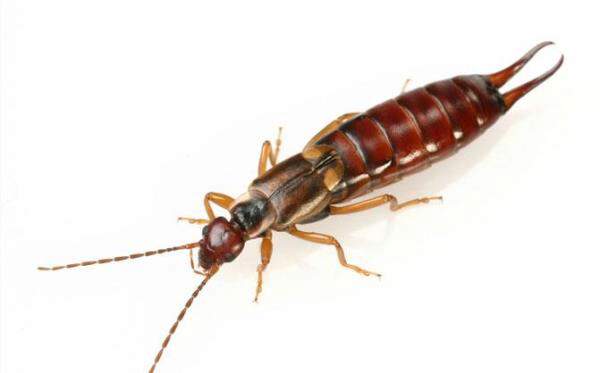Earwigs

Ask About Our
100% Eco-Friendly
Options

Earwig Control Services In Central Wisconsin

Do earwigs really go in your ear?
Contrary to European folklore, earwigs do not crawl into ears and eat peoples’ brains at night.
What is an earwig?
Earwigs are slender insects that get their name from the old European myth that they crawl into people’s ears and tunnel into their brains while they are sleeping. While this superstition has no scientific backing, the pincers located on the back of an earwig’s abdomen are quite frightening to many people. There are more than 20 different earwig species occurring in the United States. Read on to learn about they control and how to get rid of it.
What do they look like?
Earwigs range in size from ¼-1 inch long. They have elongated, flattened bodies that vary in color from pale brown with dark markings to reddish brown to black. They have six legs and a threadlike antennae that measures about half of their body length. Most notably, however, are the pincers that protrude from the back of their abdomen. They also have two pairs of wings, with their hind wings usually folding underneath their front wings. These body parts typically have a leathery appearance to them. Not all earwig species fly, and those that do only do so in short bursts.
behavior and habits
Earwigs can be found under potted plants, leaves, welcome mats, and other objects. They are also seen in cracks between pavers, bricks, and similar places.
You can also find them on plants in buds and folded leaves.
Earwigs are scavengers feeding on damaged and decaying plant matter.
They can feed on weakened or dead insects and other small organisms
They can also feed on healthy plant material.
Frequently Asked Questions
Signs of an earwig infestation may include seeing earwigs crawling in or around your home, finding small holes in leaves or flowers, and noticing damage to crops or garden plants.
Earwigs can enter your home through cracks and gaps in walls or floors, as well as on items such as clothing or plants.
Effective earwig treatments may include using insecticide sprays or dusts, as well as sealing cracks and gaps in walls and floors to prevent earwigs from entering your home. It’s best to consult with a pest control professional for the most effective treatment plan.
To prevent earwigs from entering your home, seal any cracks or gaps in walls or floors, eliminate sources of standing water, and reduce clutter in your home.
How to get rid of earwigs?
Some steps can be taken to reduce earwig numbers in your home and garden. But, when they numbers are high, you might have its problems even after taking these steps.
Keep your home and garden clean
Clean up debris that it can hide under, such as leaves, plant debris, bricks, piles of lumber, and similar things.
Thin out or remove mulch.
Trapping earwigs
You can set out rolled-up newspapers or similar objects to trap it.
Place old tuna fish cans baited with fish oil or vegetable oil.
Set them out during the evening in areas where you have noticed earwigs in your garden.
In the morning, shake the traps above a pail of soapy water to remove and kill the insects.
Excess moisture attracts
Minimize excess moisture in the landscape.
Be sure that the landscape has good drainage and that irrigation systems are working properly.
Water more thoroughly and deeply but less often so the surface of the soil remains drier.
Seal up all entry points
Caulk and repair any obvious spaces, cracks, or gaps around the outside of your home at ground level.
Pay special attention to areas around doors and windows and the juncture of the siding and the foundation.
Also, watch around water faucets and vents.
Even with these steps, some earwigs can still get inside your home. If you see any earwigs inside your home, remove them with a vacuum or a broom and dustpan.


 Service Request
Service Request